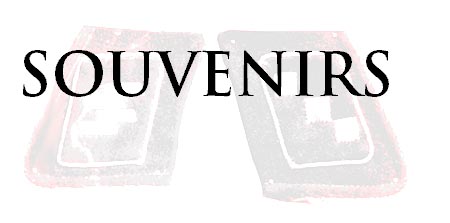 MARK BANDO'S WEBSITE
MARK BANDO'S WEBSITE
Market-Garden
BROKEN WINGS
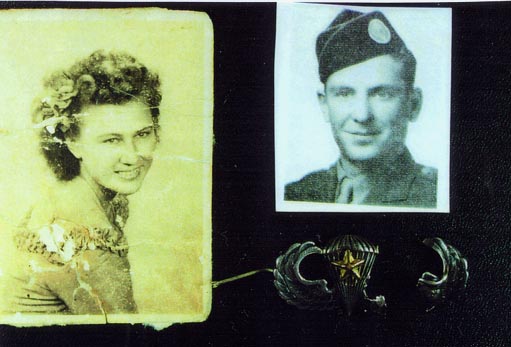 Bennie Niesner was a German-American who entered the Army from Schulenburg, Texas. After surviving the Normandy Invasion, Bennie bored a hole in a pair of British made U.S. jump wings and mounted a bronze star on them, indicating one combat jump. Before jumping into combat again in Holland, Bennie pinned the wings with a battle star into his wallet. Also in the wallet was a photo of his girlfriend, Agnes, who later became his wife. Upon parachuting into Holland on 17 September, 1944, Bennie found himself in an area which was swarming with German troops. A bullet entered his back, passed through his chest and ripped into his wallet. The round severed his jump wings, then stopped just short of piercing the photo of Agnes. The bullet was pressed against the photo, but did not penetrate it. (Agnes later said "You see, I was shot in the war too") German troops searched Bennie and stole all his possessions, except the wallet, which was covered with blood. As a parting gesture, one of them kicked Bennie in the face, breaking his jaw. They left him for dead. Bennie survived, recovered and returned to his company, D/506th PIR, 101st Airborne. He would participate in the defense of Bastogne and the final battles in Germany. The photo above shows the picture of Agnes Niesner which was almost pierced by the bullet, Bennie Niesner, and his broken wings. Courtesy of Agnes Niesner
Bennie Niesner was a German-American who entered the Army from Schulenburg, Texas. After surviving the Normandy Invasion, Bennie bored a hole in a pair of British made U.S. jump wings and mounted a bronze star on them, indicating one combat jump. Before jumping into combat again in Holland, Bennie pinned the wings with a battle star into his wallet. Also in the wallet was a photo of his girlfriend, Agnes, who later became his wife. Upon parachuting into Holland on 17 September, 1944, Bennie found himself in an area which was swarming with German troops. A bullet entered his back, passed through his chest and ripped into his wallet. The round severed his jump wings, then stopped just short of piercing the photo of Agnes. The bullet was pressed against the photo, but did not penetrate it. (Agnes later said "You see, I was shot in the war too") German troops searched Bennie and stole all his possessions, except the wallet, which was covered with blood. As a parting gesture, one of them kicked Bennie in the face, breaking his jaw. They left him for dead. Bennie survived, recovered and returned to his company, D/506th PIR, 101st Airborne. He would participate in the defense of Bastogne and the final battles in Germany. The photo above shows the picture of Agnes Niesner which was almost pierced by the bullet, Bennie Niesner, and his broken wings. Courtesy of Agnes Niesner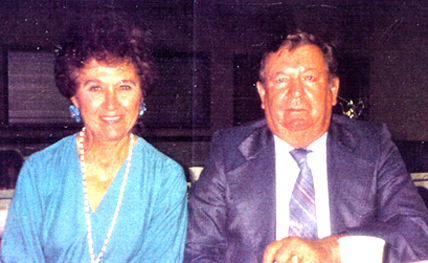 Above, Agnes and Benney photographed in 1995, a year before Bennie's death. c/o Agnes Niesner.
Above, Agnes and Benney photographed in 1995, a year before Bennie's death. c/o Agnes Niesner.
He Won a Bet and Lost His Life
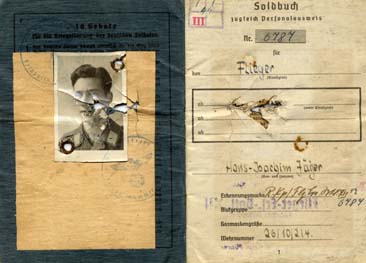 Before jumping into Holland on 17 September, 1944, some troopers in B/506th pooled their money ($5- each) totalling over $200-. This was a pot-(winner take all), to be awarded to the man who scored the first confirmed kill after hitting the ground.
Before jumping into Holland on 17 September, 1944, some troopers in B/506th pooled their money ($5- each) totalling over $200-. This was a pot-(winner take all), to be awarded to the man who scored the first confirmed kill after hitting the ground.
This Soldbuch belonged to Hans Joachim Jager, born 18 Febr, 1926, in Dusseldorf. He was a member of 7th company, of Flieger Rgt 53. Jager stood in the Zonsche Forest, firing his Mauser rifle at U.S. paratroopers, as they descended onto Drop Zone 'C'. Lt. Herbert Viertel of 2d platoon B/506th, got out of his chute, spotted Jager shooting, and returned fire, with his M-1A1 carbine. This weapon had a worn sear and as a result, it fired 2 or 3 shots with each pull of the trigger. A burst from Viertel's carbine took Jager through the chest, making holes in his ID book, as shown above. By some grisly coincidence, the bullet holes went right through the face of Jager's ID photo, inside the cover of his Soldbuch, as shown above. Lt. Viertel won the pot for this incident but he was later wounded at Noville, Belgium on December 20, 1944. He was evacuated to the 101st division's field hospital near Crossroads 'X', west of Bastogne. While in an ambulance awaiting evacuation, Lt. Viertel was captured, along with the hospital staff and all ambulatory patients. He spent the duration of WW2 at Luckenwald Germany, in Oflag 3A. Herb Clark, another member of B Company, inherited the German ID book after Lt. Viertel went MIA.
Courtesy Herb Clark, B/506th.
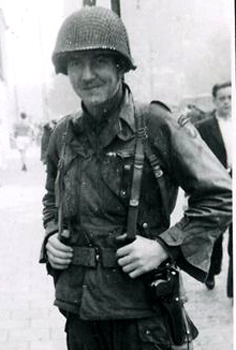 Above, the deadly Lt. Herb Viertel of B Co. 506th PIR. This shot was taken in Eindhoven on 18 September,
1944, by the van Slotten family. Viertel was later captured at Crossroads X, west of Bastogne, while a
patient at the 101st Division hospital after being SWA at Noville. He spent the duration as a POW.
Above, the deadly Lt. Herb Viertel of B Co. 506th PIR. This shot was taken in Eindhoven on 18 September,
1944, by the van Slotten family. Viertel was later captured at Crossroads X, west of Bastogne, while a
patient at the 101st Division hospital after being SWA at Noville. He spent the duration as a POW.
Before D-day, Lt Viertel's roommate at Aldbourne, England was the famous Lt Ronald Speirs, before Speirs
was transfered from C Co. to D Co. of the 506th by LTC BIlly Turner.
photo courtesy of Rene van Slooten.
German Marching Boots
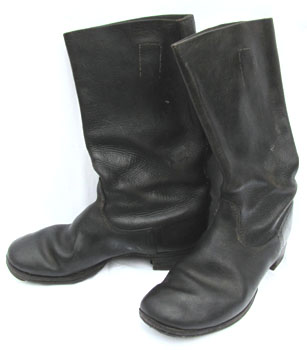
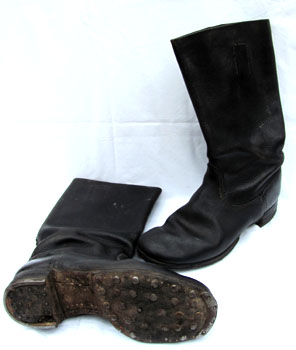 At the Trigger time
Convention #4 in Philly in 2009, Brandon McMorries gave me custody of the German boots depicted above.
His legendary Grandfather Melton 'Tex' McMorries brought them home as a souvenir. These boots were standard
combat wear for German soldiers until the low quarter boots were introduced in the last two years of
the war. Even then, these boots continued to be worn by those who had been issued them in earlier times.
These boots should not be confused with the taller jackboots worn by German officers.
At the Trigger time
Convention #4 in Philly in 2009, Brandon McMorries gave me custody of the German boots depicted above.
His legendary Grandfather Melton 'Tex' McMorries brought them home as a souvenir. These boots were standard
combat wear for German soldiers until the low quarter boots were introduced in the last two years of
the war. Even then, these boots continued to be worn by those who had been issued them in earlier times.
These boots should not be confused with the taller jackboots worn by German officers.
Note the hobnailed soles, to reduce wear, the toe and heel cleats and the small tag affixed to an inner
strap with 'Melton McMorries' written on it.
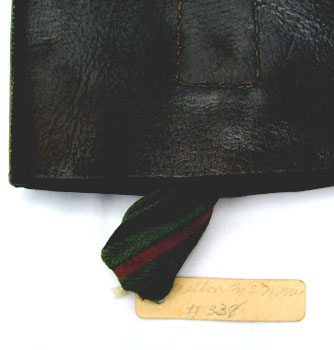 It is probable that these boots had some particular significance to Tex, perhaps a landmark # kill or a
difficult or memorable one? Regrettably we will never know.
It is probable that these boots had some particular significance to Tex, perhaps a landmark # kill or a
difficult or memorable one? Regrettably we will never know.
These boots are surprisingly rare nowadays
and when seen in collections, they are usually repaired.
Late War German Potato Masher Grenade

This late war potato masher was liberated in the Netherlands by Clyde Schneider of D/501 PIR. There are black ink
stampings on the can, with the manufacturer's code and the year 1944.
This example is of course inert-the can was
emptied of powder by Schneider before he left the ETO.
Earlier in WWII, potato masher concussion grenades were made with hollow wood handles. After, 1943, to
expedite production, some German manufacturers began making new style potato mashers with solid wood handles,
similar to a piece of broomstick. This saved the process of milling-out the handles and necessitated the attachment
of a pull igniter device directly to the can, which contained approximately 6 oz. of HE powder. That powder was highly
shock-resistant, to prevent accidental detonations. Potato mashers created no significant fragmentation when they
detonated, with the cans disintegrating into sand-ike particles. Considered an 'offensive grenade', to be thrown at
the enemy while attacking, they were like giant firecrackers, intended to stun and disorient the foe, rather than
to kill. Another late war adaptation was the addition of a steel fragmentation sleeve, which fit precisely
around the can and broke into more-effective pieces of shrapnel upon detonation. Most of these German'Frag Sleeves'
were serrated, to facilitate an even break-up of fragments, but others were smooth.
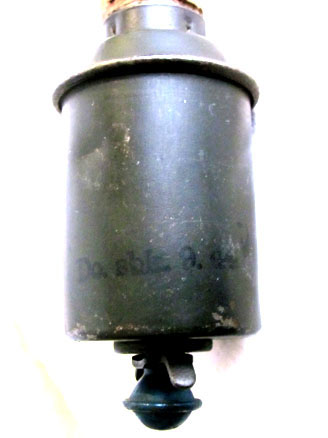 This shows details of the ink markings on the can, also the pull igniter, which is the same type used by the Germans
on their so-called 'Eiergranate' (egg grenades). To activate, the rounded blue knob was unscrewed from a threaded housing
and yanked hard. An internal attached wire was connected to the time delay element. The user had a five second time
delay to deliver the weapon to the intended target.
This shows details of the ink markings on the can, also the pull igniter, which is the same type used by the Germans
on their so-called 'Eiergranate' (egg grenades). To activate, the rounded blue knob was unscrewed from a threaded housing
and yanked hard. An internal attached wire was connected to the time delay element. The user had a five second time
delay to deliver the weapon to the intended target.
Regiment HG in the Corridor
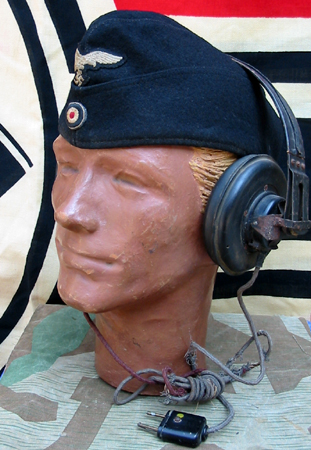 This fine quality wool cap is the boat-shaped cap for panzer crewmen of the Luftwaffe and Waffen SS. This one bears a black-edged Luftwaffe eagle, indicating it belonged to a tank crewman of the Hermann Goring Panzer division. This unit was fighting elsewhere when Allied troops landed in Holland in September, 1944. However some tanks and students from it's training school in Amersfoort, Holland were near the Son Drop Zone on 17 September, 1944. Those tanks were knocked-out by rocket-firing British 'Typhoon' fighter-bombers, before the main serials of jumpers came over DZ 'C'.
This fine quality wool cap is the boat-shaped cap for panzer crewmen of the Luftwaffe and Waffen SS. This one bears a black-edged Luftwaffe eagle, indicating it belonged to a tank crewman of the Hermann Goring Panzer division. This unit was fighting elsewhere when Allied troops landed in Holland in September, 1944. However some tanks and students from it's training school in Amersfoort, Holland were near the Son Drop Zone on 17 September, 1944. Those tanks were knocked-out by rocket-firing British 'Typhoon' fighter-bombers, before the main serials of jumpers came over DZ 'C'.
502nd medical captain George Lage treated a wounded member of the HG division and retained his cuffband as well as this cap, placing them in the cargo pocket of his M43 jump pants. The next day Captain Lage was seriously wounded by a bullet through the chest and he was evacuated before he could acquire any more souvenirs of the Holland mission.
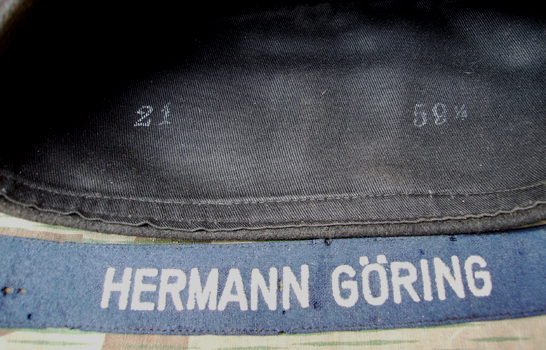 This photo shows the size marking and another coded number, stamped inside the lining of the cap. Also visible is the tunic-removed and shortened HG cuffband, which Doc Lage probably liberated from the same patient.
This photo shows the size marking and another coded number, stamped inside the lining of the cap. Also visible is the tunic-removed and shortened HG cuffband, which Doc Lage probably liberated from the same patient.
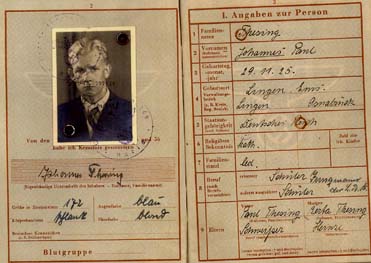 Allied Intelligence was rather surprised to discover Luftwaffe personnel from the Hermann Goring Division, attacking Allied troops along Hell's Highway in September of 1944. The actual HG Division was fighting on a different front, but their training school was at Amersfoort, Holland, just east of Utrecht. This Wehrpass shows a very Aryan-looking member of the special assignment company of the Hermann Goring Replacement and Training Regiment, who was involved in the Corridor battles. He was born 29 November, 1925, making him of prime age for late 1944 combat.
Allied Intelligence was rather surprised to discover Luftwaffe personnel from the Hermann Goring Division, attacking Allied troops along Hell's Highway in September of 1944. The actual HG Division was fighting on a different front, but their training school was at Amersfoort, Holland, just east of Utrecht. This Wehrpass shows a very Aryan-looking member of the special assignment company of the Hermann Goring Replacement and Training Regiment, who was involved in the Corridor battles. He was born 29 November, 1925, making him of prime age for late 1944 combat.
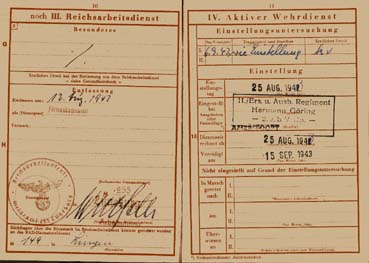 Another page from the HG Wehrpass, showing unit identification markings. This ID book was liberated by Captain Rodney Parsons of 2/502 PIR, near Sint Oedenrode.
Another page from the HG Wehrpass, showing unit identification markings. This ID book was liberated by Captain Rodney Parsons of 2/502 PIR, near Sint Oedenrode.
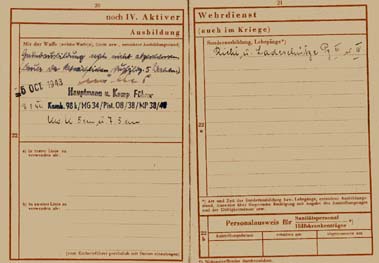 This German hadn't been in combat long enough yet to be decorated, but page 20 of his Wehrpass indicates that he was qualified on the following weapons: 98k Mauser Rifle, MG 34 machine-gun, P08 Luger and P38 9mm auto pistols, and MP38/40 machinepistol.
This German hadn't been in combat long enough yet to be decorated, but page 20 of his Wehrpass indicates that he was qualified on the following weapons: 98k Mauser Rifle, MG 34 machine-gun, P08 Luger and P38 9mm auto pistols, and MP38/40 machinepistol.
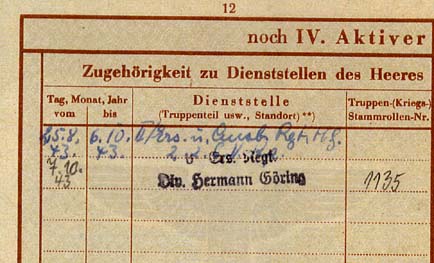 Page 12 of the book also gives a unit identification reference to the HG Division.
Page 12 of the book also gives a unit identification reference to the HG Division.
courtesy Mrs. Marian Parsons
The 6th Para Regiment Strikes Again
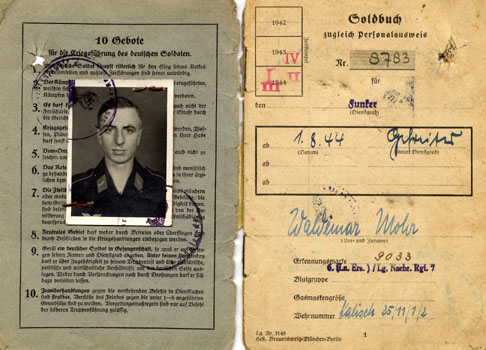 Funker (radioman) Waldemar Mohr was born on 2 July, 1925. He joined the 12th Kompanie of FJ Regiment 6 on 26 August, 1944. Mohr was KIA circa 20 September, 1944, at Sint Oedenrode, Holland by elements of 1st Bn.502 PIR. Although Mohr arrived as a replacement after Normandy, this book is evidence that the 6th Para Regiment was met by the 101st in both Normandy and Holland. An armor-piercing 30-06 round went though this book at the time of Mohr's death, and the small hole it made can be seen in the image above.
Funker (radioman) Waldemar Mohr was born on 2 July, 1925. He joined the 12th Kompanie of FJ Regiment 6 on 26 August, 1944. Mohr was KIA circa 20 September, 1944, at Sint Oedenrode, Holland by elements of 1st Bn.502 PIR. Although Mohr arrived as a replacement after Normandy, this book is evidence that the 6th Para Regiment was met by the 101st in both Normandy and Holland. An armor-piercing 30-06 round went though this book at the time of Mohr's death, and the small hole it made can be seen in the image above.
Unlike most Luftwaffe Soldbuchs, which have a sturdy dark blue cover, this specimen has a thinner grey cardboard cover, with an early droop-tailed eagle on the front.
c/o S/Sgt Roy Nickrent, HQ/1 502 PIR.
German Paratrooper Walter Sternberg
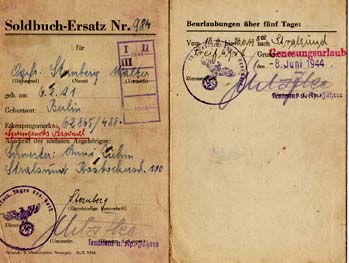 German parachutist Walter Sternberg belonged to 2d company Para Rgt 2. His unusual late-war 'Soldbuch Ersatz', is just a dual cardboard ID card, with several loose pages of clothing and equipment-issue papers included. His original Soldbuch was presumably lost or destroyed in earlier fighting. Sternberg was killed in a fierce battle with elements of H/501 northeast of Eerde, Holland on 26 September, 1944. After the fighting, Major R.J. Allen, the regimental S-3 of the 501 came around and ordered the Hog Troop men to bury German bodies. They were too tired, so Carl Beck of 3rd platoon, just placed the German bodies in a culvert and covered them with rutabagas or sugar beets.
German parachutist Walter Sternberg belonged to 2d company Para Rgt 2. His unusual late-war 'Soldbuch Ersatz', is just a dual cardboard ID card, with several loose pages of clothing and equipment-issue papers included. His original Soldbuch was presumably lost or destroyed in earlier fighting. Sternberg was killed in a fierce battle with elements of H/501 northeast of Eerde, Holland on 26 September, 1944. After the fighting, Major R.J. Allen, the regimental S-3 of the 501 came around and ordered the Hog Troop men to bury German bodies. They were too tired, so Carl Beck of 3rd platoon, just placed the German bodies in a culvert and covered them with rutabagas or sugar beets.
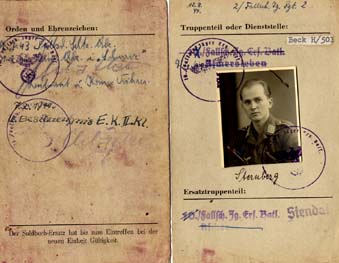 Before burying Sternberg, Beck took his fallshirmschutzen abzeichen -(parachutist qualification badge in metal), and his wallet, containing the documents shown here. This card indicates that Sternberg's awards included the FJ qualification badge, the Iron Cross 2d class, and the wound badge in black.
Before burying Sternberg, Beck took his fallshirmschutzen abzeichen -(parachutist qualification badge in metal), and his wallet, containing the documents shown here. This card indicates that Sternberg's awards included the FJ qualification badge, the Iron Cross 2d class, and the wound badge in black.
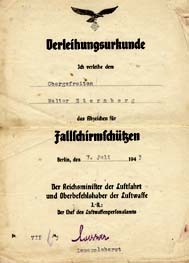
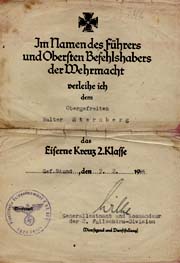 The certificate above left, was awarded to Sternberg when he graduated the German parachute school at Stendal, Germany, west of Berlin. It is signed by a Colonel General of the Luftwaffe. This was found folded inside Sternberg's wallet. The Urkunde (award document), above right, is for the Iron Cross 2d class. This indicates Sternberg won it on 7 February,1944, on the Eastern Front. He was a member of the 2nd Fallschirm Division. It is signed by a Lt. General of the Luftwaffe.
The certificate above left, was awarded to Sternberg when he graduated the German parachute school at Stendal, Germany, west of Berlin. It is signed by a Colonel General of the Luftwaffe. This was found folded inside Sternberg's wallet. The Urkunde (award document), above right, is for the Iron Cross 2d class. This indicates Sternberg won it on 7 February,1944, on the Eastern Front. He was a member of the 2nd Fallschirm Division. It is signed by a Lt. General of the Luftwaffe.
Sternberg's wallet also contained photos of several of his very pretty girlfriends ("nothing obscene' Beck recalls,'just pictures of some pretty girls."). Beck brought the FJ wings, wallet and contents home after WW2 and showed the items to a lot of friends. Somewhere along the line, the wallet and photos of the girls disappeared. Somebody also 'liberated' the fallschirmjager wings. The ID papers and award documents shown here, are now in the webmaster's collection.
Carl Beck's Combat Diary
To better understand what led up to Sternberg's demise, it is instructive to read the various entries of Carl Beck's diary, starting with the jump on 17 September, 1944.
September 17, 1944:Hit the silk at 13:15-lost helmet on the jump (evening) freezing my head off-don't have a carbine...lost it on the drop too.
Sept. 18: Kraut ran us out of Eerde this morning..We had to go around a flank to knock him out again. 1400 Kraut counterattacked with tanks and drove us back again.
Sept. 19:Ran kraut out of town again this morning & it was a little tough this time. He's getting stubborn, I guess.
Sept. 20: Dutchman came galloping out of his house with a Dutch helmet. Makes me look like Ed Wynn, the Fire Chief...
Sept. 21: Watching B-17's and C-47's resupply us today& sure was a beautiful sight. While Johnson and I were walking to O.P.with chow kraut opened-up on low flying C-47s and the H.E. was screaming and bursting all around us. My life was saved by a small pine tree about five feet away. A 20mm hit it and exploded. The damn thing was coming straight for me.
Sept. 22:3rd Bn. to attack Schijndel. Jumped off about 2300. Hit 1:55 phase line and then all hell broke loose. Had to dig krauts out of holes and houses with W.P. grenades.
Sept 23: Moved back to Eerde without incident. A 20mm hit a scrub pine right beside my head and I couldn't see for a few minutes.
Sept. 24: Got fired on by a combat patrol and captured 11 krauts. I hear we made contact with the Limeys at last...guess the whole operation is a miserable failure.
Sept. 25: Made contact with combat patrol from Hermann Goring Division. Sure went round and round until after dark. Duffy got a slug in the pack and I got my beanie turned around on my head by a bunch of m.g. fire. Darn close. Finally got knocked back into the ditch when a sniper's bullet hit a tree right beside my head. Knocked me coo-coo for awhile & a few splinters in my face, but nothing serious. Two wounded krauts in our ditch...finally pulled out with one prisoner and left all wounded. No casualties, but Lt. Davidson got slugs through his pack and patch pockets and canteen. He sure is in solid with the platoon now. I didn't think anyone could move, but he sure did. We are sure proud of him. (webmaster's note:2d Lt.Charles K. Davidson had fought in Normandy with Service Co. 501, and was transfered into H/501 as an assistant platoon leader just before Market-Garden).
Sept. 26: Moved up to take over part of the line between 'I' Co. and 2d Bn. Ran smack into an element of German paratroops. Met them halfway and sure got a mess of them. A corporal in the 1st platoon is dead and another private is dead. Lt. Davidson, Aubin, Duffy and I were out abreast of the platoon. Lt. Davidson was KIA by a LMG in the chest. Aubin got his .45. Took about two hours to drive them off and there is dead krauts laying all around. Sure was hot for awhile. Must have got about 35 krauts. Johnson was killed by a machinepistol, but Schleibaum got that kraut. Pulled back about 100 yards and set up F.P.L....dead kraut laying here (Sternberg), and we had to cover him with sugar beets. Got kraut parachute wings and a wallet with kraut F.P.L. in it. Turned that in to S-2. A quiet night after we got dug-in.
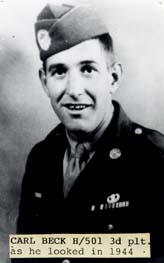 Artifacts and diary excerpts courtesy Carl Beck H/501 PIR; Carl's combat exploits in Normandy, Holland and at Bastogne, can be found in 'Vanguard of the Crusade' by the webmaster.
Artifacts and diary excerpts courtesy Carl Beck H/501 PIR; Carl's combat exploits in Normandy, Holland and at Bastogne, can be found in 'Vanguard of the Crusade' by the webmaster.
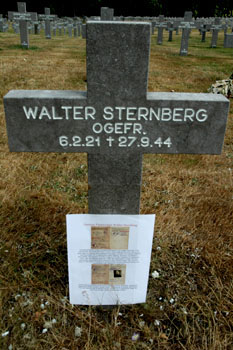 A 2006 photo of Walter Sternberg's final resting place, in the German military cemetery at Ysselsteyn, Holland. Photo courtesy of Erwin Janssen.
A 2006 photo of Walter Sternberg's final resting place, in the German military cemetery at Ysselsteyn, Holland. Photo courtesy of Erwin Janssen.
Souvenir of Schijndel
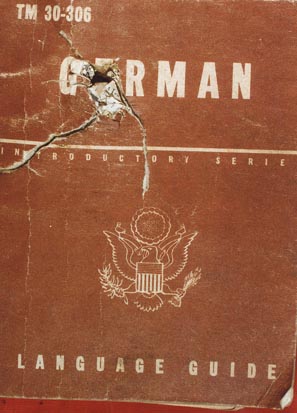 During the attack of 1st Bn 501 PIR to Schijndel, Holland in September, 1944, Tom Fracassi of A/501 was carrying the German language guide pictured above, in his rear pants pocket. Near the canal, a German bullet passed through the book and struck Tom in the butt. He was exacuated, but fortunately recovered from the wound.
During the attack of 1st Bn 501 PIR to Schijndel, Holland in September, 1944, Tom Fracassi of A/501 was carrying the German language guide pictured above, in his rear pants pocket. Near the canal, a German bullet passed through the book and struck Tom in the butt. He was exacuated, but fortunately recovered from the wound.
Tom's platoon leader 'Monk' Mier recalls hearing someone yell for a medic.
Mier yelled "Who got HIT?"
A trooper yelled "Fracassi!"
Mier yelled "Where did he get it?"
"Through both cheeks" was the reply.
Tom's former platoon Sgt, Jack Lebzelter, was a stocky redhead from Newark, N.J. Jack left the outfit just before Normandy, after landing on an English fence on a practice night jump and severely breaking his leg. Lebzelter's men had laughed when he announced that after the war he intended to act in movies. Jack Lebzelter now resides in Malibu Beach, CA and is better known to movie fans as Jack Warden. Although his paratrooper buddies phone him from the 501st regimental reunion each year, he refuses to meet them at the reunions. He feels he doesn't belong, because he had to leave the 501 before combat. His buddies have the utmost pride and affection for him, and wish he would attend. Life is short, but such is Jack Warden's personal code of honor.
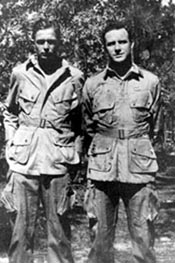
 The photo above left, shows Wes Bates and platoon (Staff) Sgt Jack Lebzelter of A/501 at Camp Mackall, N.C. in 1943. Lebzelter became famous on television and in the movies under his postwar screen name of Jack Warden. Photo courtesy Bill Spivey. Above right, a more contemporary portrait of Jack Warden-even this shot is now 20 years old, but should be recognizable to movie fans.
The photo above left, shows Wes Bates and platoon (Staff) Sgt Jack Lebzelter of A/501 at Camp Mackall, N.C. in 1943. Lebzelter became famous on television and in the movies under his postwar screen name of Jack Warden. Photo courtesy Bill Spivey. Above right, a more contemporary portrait of Jack Warden-even this shot is now 20 years old, but should be recognizable to movie fans.
Lt. Viertel Takes Out Another
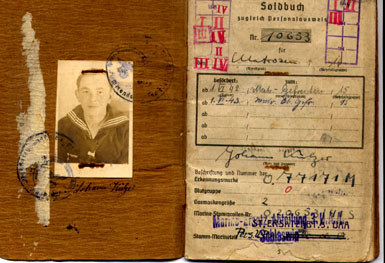 Lt. Herb Viertel of B/506th, roomed with the famous Lt. Ronnie Speirs in Aldbourne, England. Like Speirs, Viertel was a deadly combat soldier, who had done a lot of hunting in civilian life.
Lt. Herb Viertel of B/506th, roomed with the famous Lt. Ronnie Speirs in Aldbourne, England. Like Speirs, Viertel was a deadly combat soldier, who had done a lot of hunting in civilian life.
On 5 October, 1944, Lt. Viertel was forced to kill the owner of the Soldbuch pictured above, after the man was captured. The German kept putting one hand inside the tunic wrist cuff of his opposite arm. Lt. Viertel verbally ordered him to stop what he was doing. When the German failed to comply, Viertel shot him dead. Closer inspection of the German's body revealed he had an egg shaped concussion grenade hidden up his sleeve.
This German was "Obergrefreiter"(senior corporal)Johannes Kubzer, in the Kriegsmarine (German Navy). Also though many Navy personnel were transfered to ground combat duties late in the war, it is uncommon to see those types wearing blue jumpers in their Soldbuch photos. This man attended a Naval Flak school and was assigned to the 1st Naval Shore Regiment at the time of his demise.
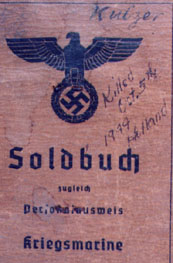 This is the front cover of the deceased sailor's soldbuch, identical to the covers of Army Soldbucher, except for the word 'Kriegsmarine' at the bottom. Note that Lt. Viertel wrote: "killed Oct.5th 1944 Holland" on the cover. At that time, the 506th was engaged with the enemy at Opheusden, on the Island.
This is the front cover of the deceased sailor's soldbuch, identical to the covers of Army Soldbucher, except for the word 'Kriegsmarine' at the bottom. Note that Lt. Viertel wrote: "killed Oct.5th 1944 Holland" on the cover. At that time, the 506th was engaged with the enemy at Opheusden, on the Island.
Later, while a wounded patient, Viertel became a prisoner at Crossroads 'X' west of Bastogne, when the Division hospital was captured. The Soldbuch pictured above was back in Camp Mourmelon, in Viertel's footlocker, which was mailed to his home address after he went MIA. When Viertel returned home in 1945, he found that mail handlers had pilfered almost everything from the trunk, except this Soldbuch. c/o Herb Viertel
Wounded Equipment
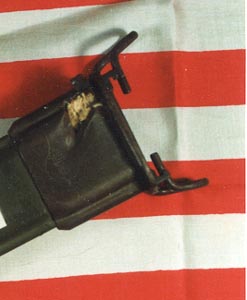 On 4 October, 1944, Company 'C' of the 506th fought their way into the town of Opheusden, Holland. There, they battled from building to building all day, until darkness set in. During that day's fighting, Sgt Bill Knight had two M-1 rifles shot from his hands, damaged beyond repair. At the end of the day, during a break in the action, he noticed a mortar shell fragment had torn a hole in the metal top of his bayonet scabbard (photo above). During all this, Knight never received a scratch.
Opheusden Victim
On 4 October, 1944, Company 'C' of the 506th fought their way into the town of Opheusden, Holland. There, they battled from building to building all day, until darkness set in. During that day's fighting, Sgt Bill Knight had two M-1 rifles shot from his hands, damaged beyond repair. At the end of the day, during a break in the action, he noticed a mortar shell fragment had torn a hole in the metal top of his bayonet scabbard (photo above). During all this, Knight never received a scratch.
Opheusden Victim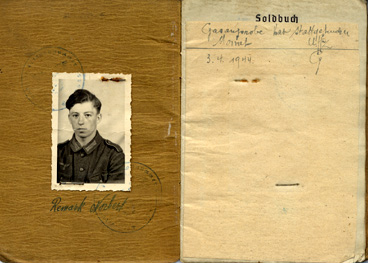 One night in October, 1944, several troopers of 3rd Bn 506th ambushed a passing company of German infantrymen. One of the resulting casualties was Norbert Remark of Infantry Geschutz Company 79. 1st Sgt Fred Bahlau kept his Soldbuch as a souvenir of that action near the canal and railroad station. Remark would have been assigned to the (13th) Infantry Close Support Howitzer Company of a Volksgrenadier division at that time. In late 1944, these companies had 150mm and 75mm howitzers, and 120mm mortars.
One night in October, 1944, several troopers of 3rd Bn 506th ambushed a passing company of German infantrymen. One of the resulting casualties was Norbert Remark of Infantry Geschutz Company 79. 1st Sgt Fred Bahlau kept his Soldbuch as a souvenir of that action near the canal and railroad station. Remark would have been assigned to the (13th) Infantry Close Support Howitzer Company of a Volksgrenadier division at that time. In late 1944, these companies had 150mm and 75mm howitzers, and 120mm mortars.
Opheusden Whistle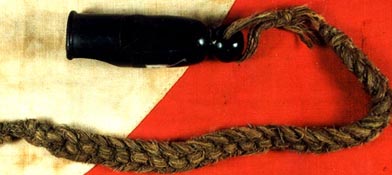 On the morning of 7 October, 1944, Company 'C' of the 506th was down to 26 men, under leadership of Lt Albert Hassenzahl. They were given the assignment to attack a woods east of Opheusden, Holland where a reduced battalion of German troops were dug-in. Mariano Sanchez called in 81mm mortar fire from 2nd Bn HQ Co., and eventually 200 Germans came out to surrender. Another fifty remained in the woods, dead.
On the morning of 7 October, 1944, Company 'C' of the 506th was down to 26 men, under leadership of Lt Albert Hassenzahl. They were given the assignment to attack a woods east of Opheusden, Holland where a reduced battalion of German troops were dug-in. Mariano Sanchez called in 81mm mortar fire from 2nd Bn HQ Co., and eventually 200 Germans came out to surrender. Another fifty remained in the woods, dead.
As the POWs were being rounded-up and searched, Sgt Bill Knight observed a German sergeant periodically blowing the whistle shown above. Thinking it might be some sort of signal to other Germans still fighting, Sgt Knight confiscated the whistle, which is a standard German non com's whistle on what appears to be a braided horsehair cord.


































